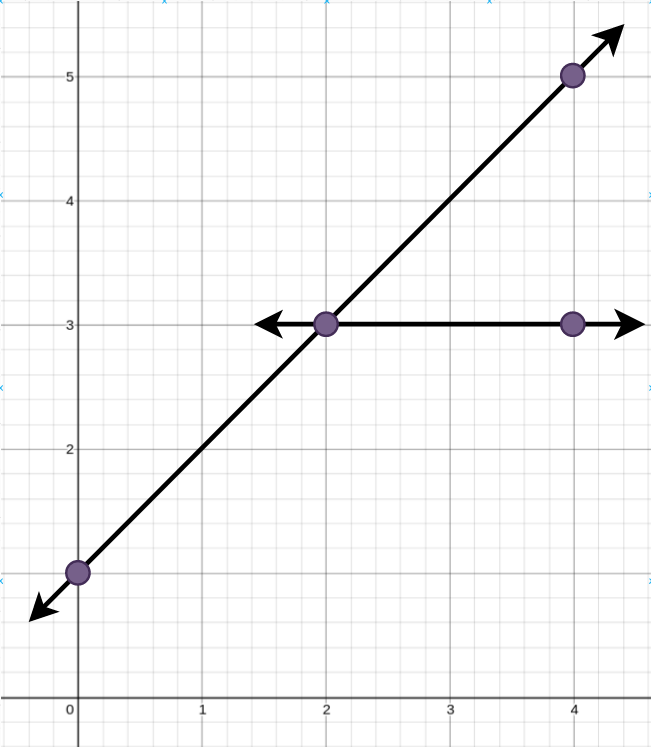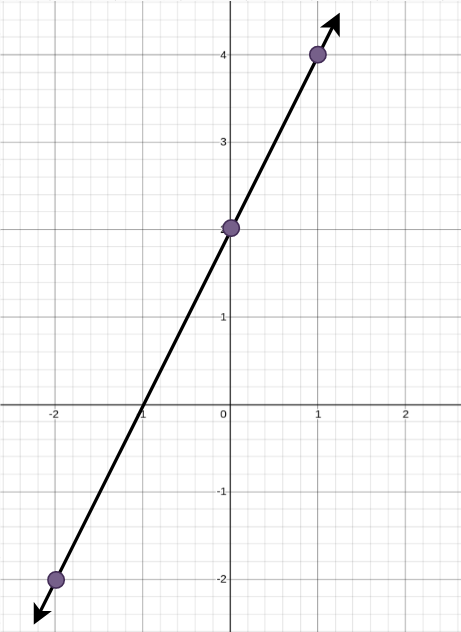Welcome to Subscribe On Youtube
2152. Minimum Number of Lines to Cover Points
Description
You are given an array points where points[i] = [xi, yi] represents a point on an X-Y plane.
Straight lines are going to be added to the X-Y plane, such that every point is covered by at least one line.
Return the minimum number of straight lines needed to cover all the points.
Example 1:

Input: points = [[0,1],[2,3],[4,5],[4,3]] Output: 2 Explanation: The minimum number of straight lines needed is two. One possible solution is to add: - One line connecting the point at (0, 1) to the point at (4, 5). - Another line connecting the point at (2, 3) to the point at (4, 3).
Example 2:

Input: points = [[0,2],[-2,-2],[1,4]] Output: 1 Explanation: The minimum number of straight lines needed is one. The only solution is to add: - One line connecting the point at (-2, -2) to the point at (1, 4).
Constraints:
1 <= points.length <= 10points[i].length == 2-100 <= xi, yi <= 100- All the
pointsare unique.
Solutions
-
class Solution { private int[] f; private int[][] points; private int n; public int minimumLines(int[][] points) { n = points.length; this.points = points; f = new int[1 << n]; return dfs(0); } private int dfs(int state) { if (state == (1 << n) - 1) { return 0; } if (f[state] != 0) { return f[state]; } int ans = 1 << 30; for (int i = 0; i < n; ++i) { if (((state >> i) & 1) == 0) { for (int j = i + 1; j < n; ++j) { int nxt = state | 1 << i | 1 << j; for (int k = j + 1; k < n; ++k) { if (((state >> k) & 1) == 0 && check(i, j, k)) { nxt |= 1 << k; } } ans = Math.min(ans, dfs(nxt) + 1); } if (i == n - 1) { ans = Math.min(ans, dfs(state | 1 << i) + 1); } } } return f[state] = ans; } private boolean check(int i, int j, int k) { int x1 = points[i][0], y1 = points[i][1]; int x2 = points[j][0], y2 = points[j][1]; int x3 = points[k][0], y3 = points[k][1]; return (x2 - x1) * (y3 - y1) == (x3 - x1) * (y2 - y1); } } -
class Solution { public: int minimumLines(vector<vector<int>>& points) { auto check = [&](int i, int j, int k) { int x1 = points[i][0], y1 = points[i][1]; int x2 = points[j][0], y2 = points[j][1]; int x3 = points[k][0], y3 = points[k][1]; return (x2 - x1) * (y3 - y1) == (x3 - x1) * (y2 - y1); }; int n = points.size(); int f[1 << n]; memset(f, 0, sizeof f); function<int(int)> dfs = [&](int state) -> int { if (state == (1 << n) - 1) return 0; if (f[state]) return f[state]; int ans = 1 << 30; for (int i = 0; i < n; ++i) { if (!(state >> i & 1)) { for (int j = i + 1; j < n; ++j) { int nxt = state | 1 << i | 1 << j; for (int k = j + 1; k < n; ++k) { if (!(nxt >> k & 1) && check(i, j, k)) { nxt |= 1 << k; } } ans = min(ans, dfs(nxt) + 1); } if (i == n - 1) { ans = min(ans, dfs(state | 1 << i) + 1); } } } return f[state] = ans; }; return dfs(0); } }; -
class Solution: def minimumLines(self, points: List[List[int]]) -> int: def check(i, j, k): x1, y1 = points[i] x2, y2 = points[j] x3, y3 = points[k] return (x2 - x1) * (y3 - y1) == (x3 - x1) * (y2 - y1) @cache def dfs(state): if state == (1 << n) - 1: return 0 ans = inf for i in range(n): if not (state >> i & 1): for j in range(i + 1, n): nxt = state | 1 << i | 1 << j for k in range(j + 1, n): if not (nxt >> k & 1) and check(i, j, k): nxt |= 1 << k ans = min(ans, dfs(nxt) + 1) if i == n - 1: ans = min(ans, dfs(state | 1 << i) + 1) return ans n = len(points) return dfs(0) -
func minimumLines(points [][]int) int { check := func(i, j, k int) bool { x1, y1 := points[i][0], points[i][1] x2, y2 := points[j][0], points[j][1] x3, y3 := points[k][0], points[k][1] return (x2-x1)*(y3-y1) == (x3-x1)*(y2-y1) } n := len(points) f := make([]int, 1<<n) var dfs func(int) int dfs = func(state int) int { if state == (1<<n)-1 { return 0 } if f[state] > 0 { return f[state] } ans := 1 << 30 for i := 0; i < n; i++ { if (state >> i & 1) == 0 { for j := i + 1; j < n; j++ { nxt := state | 1<<i | 1<<j for k := j + 1; k < n; k++ { if (nxt>>k&1) == 0 && check(i, j, k) { nxt |= 1 << k } } ans = min(ans, dfs(nxt)+1) } if i == n-1 { ans = min(ans, dfs(state|1<<i)+1) } } } f[state] = ans return ans } return dfs(0) }